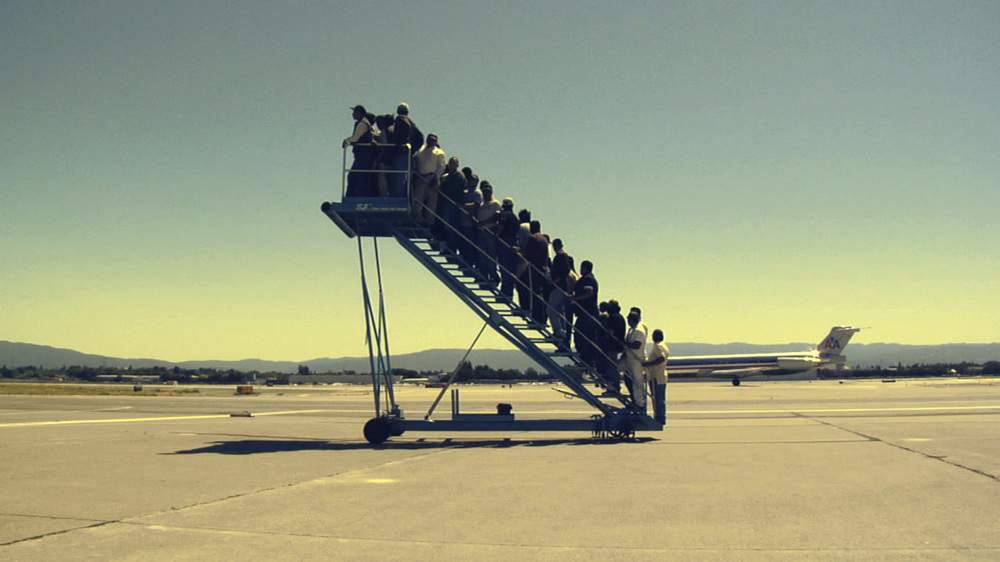With Center of Temporary Permanence (2007), Adrian Paci wins the Metamorphosis award, the first event dedicated to video art of Villae Film Festival, organized by the Villa Adriana and Villa d’Este Institute - Villae and the Cultural Association Seven. The award consists of the possibility for the artist to shoot his or her own short film within the Villae.
Announcing the winner is Andrea Bruciati, art historian and director of the Tiburtine Institute, on the last evening of the fourth edition of the Villae Film Festival.
Twelve works reviewed were: Yuri Ancarani, Baal, 2007; Elisabetta Benassi, You’ll never walk alone, 2000; Simone Berti, Luce, 1993; Alex Cecchetti and Christian Frosi,Crossing the Millau Bridge, 2005; Paolo Chiasera, Lo scoglio alto, 2005; Michael Fliri, Come out and play with me, 2003; Marzia Migliora, Efi, 2003; Ottonella Mocellin and Nicola Pellegrini, Hurt so good, 1999; Adrian Paci, Centro di permanenza temporanea, 2007; Alessandra Spranzi, Il viaggio, 2004; Nico Vascellari, Nico & The Vascellaris, 2005; Italo Zuffi, Perimetro, 2000.
The competing works are on view through Nov. 13, 2022, in the Kaleidoscope multimedia space at Villa Adriana as part of the third exhibition episode of Vita Nova: Art in Italy in the Light of the New Millennium, which includes a survey of Italian art being historicized from 1990 to 2010.
"It certainly turns out the great topicality of a work that, although made fifteen years ago, unfortunately still remains of cogent interest today because it delves inside the guilt of us Westerners. Certainly the reflection extends to roots understood not only as a dramatic private experience, but as an existential condition shared by an unstable humanity, with no more firm bonds of belonging, where discriminatory remains which side of the world one is born on. Raw in the tragic simplicity of its language, it turns out to be a classic work because of the communicative immediacy and formal essentiality with which it is conceived," said Andrea Bruciati.
San Jose Airport, California: a group of migrants walk in line toward the stairs of an airplane. The camera gets close to their faces scrutinizing their looks lost on the horizon, the wrinkles in their skin, the details of their clothing as if it were the eye of a supernatural or simply customs authority inspecting them. Gradually the staircase fills up with more and more people crowding in; only small problem: there is no plane. The migrants remain stuck on the isolated staircase in the middle of the airport: they are no longer where they were, but they have no destination; they are in limbo. Their existential condition is to remain suspended, in an indefinite place, motionless extras of an impossible destiny while behind them planes land and arrive, unaware of the drama that is being perpetuated.
Adrian Paci was born in 1969 in Albania and lives and works in Milan. He studied painting at the Academy of Arts in Tirana and his teacher was Edi Rama. In his works Adrian Paci uses different languages making paintings, sculptures and videos. One of his series consists of paintings made from stills from Pier Paolo Pasolini’s The Gospel According to St. Matthew, later merged into the installation Cappella Pasolini. The themes of exile, distance, and detachment recur in many of his works. He has exhibited c his works all over the world, from Milan to Zurich, Los Angeles to Stockholm, Tel Aviv, Amsterdam, Istanbul, London, and New York.
Image: Adrian Paci, Temporary Residence Center (2007; video, 4’32", 16/9)
 |
| Villae Film Festival, Adrian Paci wins Metamorphosis award dedicated to video art |
Warning: the translation into English of the original Italian article was created using automatic tools. We undertake to review all articles, but we do not guarantee the total absence of inaccuracies in the translation due to the program. You can find the original by clicking on the ITA button. If you find any mistake,please contact us.